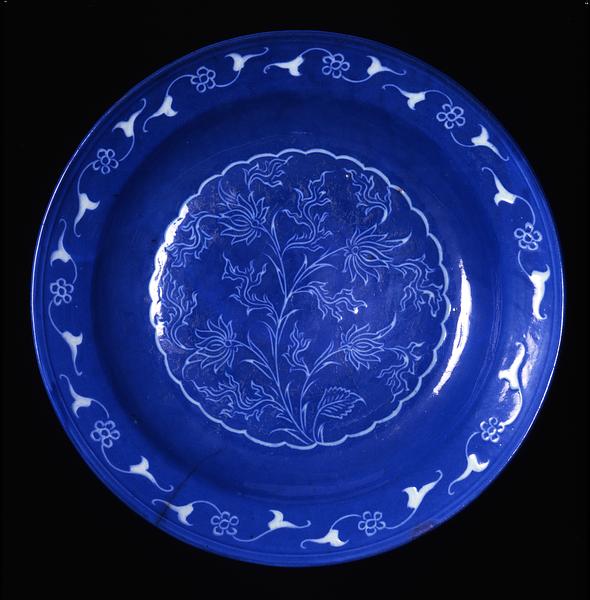Fritware dish, with decoration cut through a blue slip under a transparent glaze
Iran, Kerman?; 17th century
H: 8.5; Diam: 46.5 cm
In the final analysis, this unusually large dish reflects the same Chinese influence that was found in by far the majority of Persian blue and white ceramics after c. 1400. But there are clear differences. The nervous peony, whose petals almost look like Chinese cloud ornaments, is of Far Eastern origin, while the rim’s split-leaf ornamentation, in contrast, is purely Islamic.
The technique is almost diametrically opposed to the normal one used, in which a white dish is painted in blue. This dish was covered with an intense blue slip through which the decoration was cut, revealing the white body.
Inv. no. 1/1986
Published in:
Sotheby’s, London, 18/4-1984, lot 201;
Art from the World of Islam. 8th-18th century, Louisiana, Humlebæk 1987, cat.no. 249;
Kjeld von Folsach: Islamic art. The David Collection, Copenhagen 1990, cat.no. 169;
Kjeld von Folsach, Torben Lundbæk and Peder Mortensen (eds.): Sultan, Shah and Great Mughal: the history and culture of the Islamic world, The National Museum, Copenhagen 1996, cat.no. 263;
Jessica Hallett, Conceicao Amaral (eds.): Cultures of the Indian Ocean, Museu Nacional de Arte Antiga, Lissabon 1998, cat.no. 54, p. 198;
Kjeld von Folsach: Art from the World of Islam in The David Collection, Copenhagen 2001, cat.no. 247;
Sheila S. Blair and Jonathan M. Bloom (eds.): Cosmophilia. Islamic Art from the David Collection, Copenhagen, McMullen Museum of Art, Boston College, Boston 2006, cat.no. 102;
Patricia F. Ferguson: “Safavid monochrome-glazed pottery from Kirman: decoration and dating” in Transactions of the Oriental Ceramic Society, 73, 2008-2009, 2010, p. 126;
Kjeld von Folsach: Flora islamica: plantemotiver i islamisk kunst, Davids Samling, København 2013, cat.no. 54;
